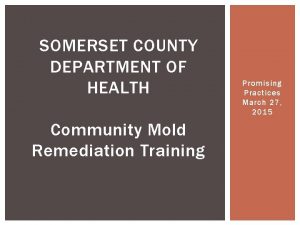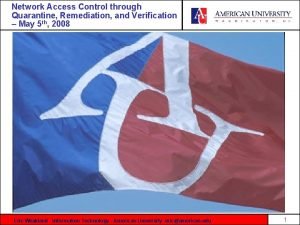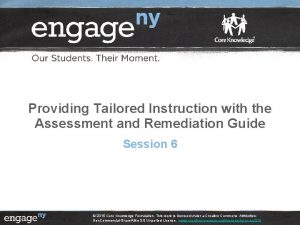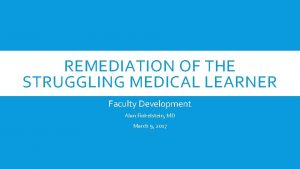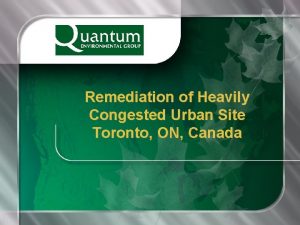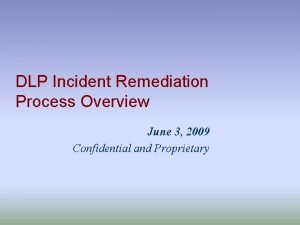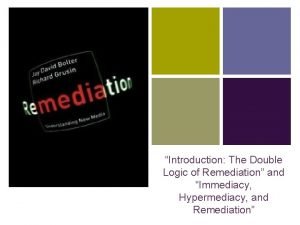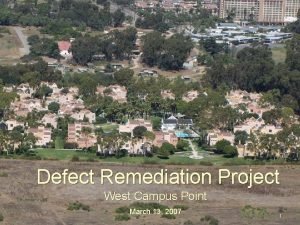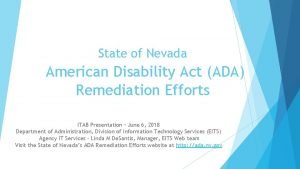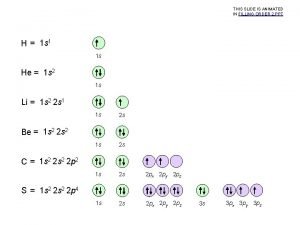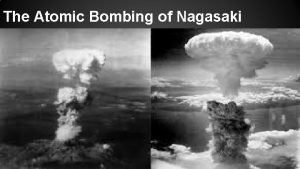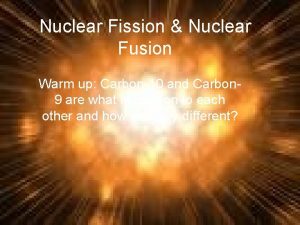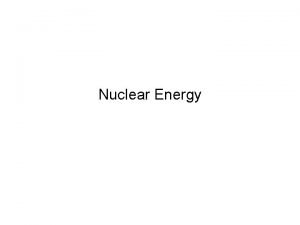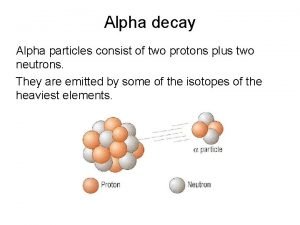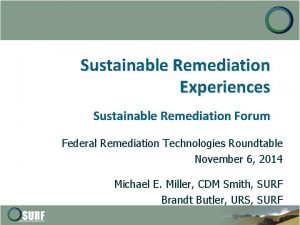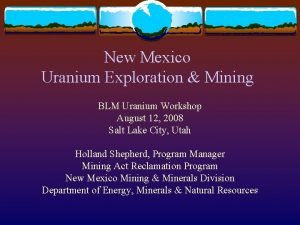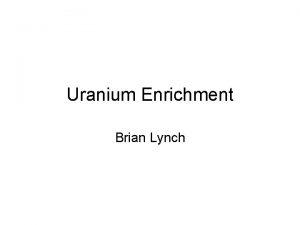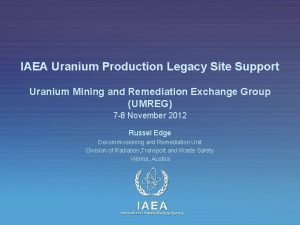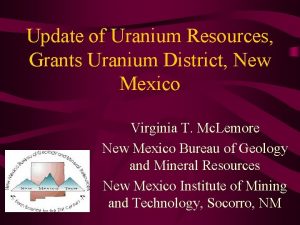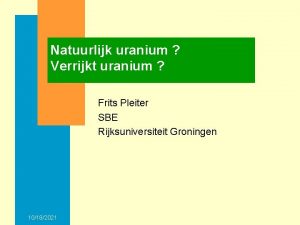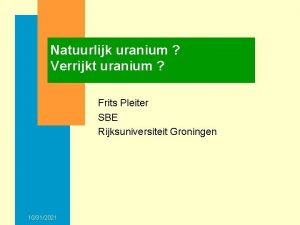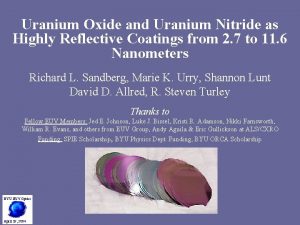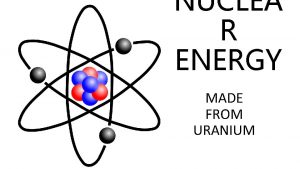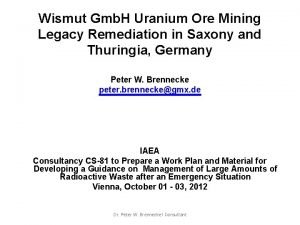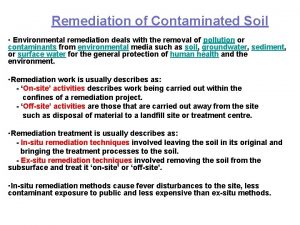Remediation in the life cycle of a uranium

















- Slides: 17

Remediation in the life cycle of a uranium mine: The Ranger experience Peter Waggitt Northern Territory Australia Environet – Vienna December 2017

Tajikistan U Mining and remediation • Mining is an industry with a long history of production but a poor history of remediation (until relatively recently) • Historically remediation was rarely considered in mine planning until the end, if then • Legacy sites abound globally and represent a great liability to governments and ultimately the community. • Examples can be found in Central Asia, Australia, Africa, Europe, etc • Uranium mines present additional concerns to the community • Modern uranium mining, since 1975 , has made an effort to manage the whole life cycle – in some countries • Modern practice is different and still developing, but with along way to go • Some good examples of current practice may be seen in Australia • Ranger and Nabarlek mines in Australia are examples of such U modern mines where remediation has been incorporated into the life cycle of the operations. Australia Gabon

Uranium Mining and the Northern Territory • A long history… • 1869: Goyder found a green coloured mineral “that was not copper” – torbernite perhaps? • 1912, Dr H L Jensen, then Government Geologist, reported the existence of uranium in the Rum Jungle area • 1949: Jack White found Uranium at Rum Jungle • 1953: Bruce Walpole found U at Coronation Hill • Contemporary finds included Adelaide River, Sleisbeck and all the other South Alligator Valley deposits - Scinto 1 -6, Rockhole. El Sherana, Saddle Ridge, etc • Queensland Border area • Alligator Rivers Region Rum Jungle mine – White’s Open pit.

Uranium mining post 1945 Since 1954 Uranium mining activity has been more or less continuous in the NT • Rum Jungle operated between 1954 and 1971 mining and processing copper and uranium ores - now the focus of a remediation planning project • Significant deposits were found in the Pine Creek area and up into the Alligator Rivers Region • South Alligator Valley - 54 radiological anomalies; 19 mine sites • Operated between 1959 and 1965 • The total production for this field was approximately 840 tonnes of U 308. • Commonwealth funded hazard reduction works 1990 -92 • Legacy sites now remediated 2007 -2009 • Other Legacy U Mines • Older mines in the Pine Creek area e. g. Fleur de Lys • Now lies within a gold mine that has been restarted a couple of times • Adelaide River Mines - remediated • Westmoreland area - remediated


Modern Uranium mining in NT Australia Nabarlek 1979 -1988 Ranger 1980 - present

Uranium mine remediation planning • Prior to Nabarlek mine (1978 -1988) remediation was an activity generally left to the end of operations if considered at all • Nabarlek was the first modern U mine in Australia to go through an EIS • Lessons from the legacy of Rum Jungle (and other non-U mines) had started to be recognised • Nabarlek was required to have a remediation plan from the start and the mining agreement with Aboriginal Traditional Owners did recognise the need to have some plans, albeit not well defined • Final remediation objectives were agreed but quite high level and hard to measure

Nabarlek Experience • Discovery in 1970, a surface outcrop • EIS and Fox Inquiry 1975 -1977 • Mining took 143 days in dry season of 1979 • Ore stockpiled with a concrete cover (Oct 1979) • Mill construction approved 11 July 1979 • Mill built in the wet season (Oct ‘ 79 to Apr ‘ 80) • Fly in/Fly out operation with a camp on site • Milling commenced June 1980, ceased 1988 • 10, 850 t U 3 O 8 production • Mill tailings deposited directly to the pit • 1994 Directed to remediate by December 1995 • Pond cleaning 1992, dismantling 1994 -5 wet season • Works completed December 1995 but some infrastructure remains

Nabarlek – remediation strategy • Little guidance from regulators • Clear, measureable remediation criteria absent • Initial plan for return of area to native vegetation “blending with country side”; suitable for traditional activity • Funding guaranteed by company • Dedicated remediation engineer to update plans annually • Documentation revised continuously • Progressive remediation wherever possible • Work plan schedule to complete in one dry season • Minimum infrastructure left - but all at request of land owners

Nabarlek – remediation history & situation today • Change of some plans due to different generation of land owners • Decommissioning went well • Infrastructure issues developed when sale fell through and landowners ideas changed • Revegetation affected by weather, fire and time/resources with change of operating company • Some concerns about state of the surface from landowners • Minor works remain to be done • No clear path to closure and certification at present

Ranger Uranium - history • • • Discovered 1969; Started operations 1981; mining Pit 1 ended 1995 1978 - Remediation matters set out in Environmental Requirements (ER) e. g tailings in pits ER are the overarching elements of regulation under Atomic Energy Act and Mining Management Act Pit 3 commenced 1997; mining Pit 3 ended 2012 30 M t under fill put into Pit 3 as preparation for tailings repository Ranger 3 Deeps resource (u/g) announced in 2009; work commenced on exploration decline 2011 2015 Board decision not to proceed to FFS with R 3 D Current production ~2 – 2. 2 ktpa from stockpiles Operations to end January 2021; site to be cleared by January 2026 RUM production to date exceeds 120, 000 t uranium oxide

Ranger – remediation planning • From the beginning of operations a remediation plan was required • Security for remediation costs calculated annually and held by Commonwealth Government (amount not publically disclosed) • Plan to be updated annually for an assumed “rapid shutdown” • However, the primary purpose of this plan was to set the size of the remediation security and it contained little detail for true closure • High level remediation objectives were set but no details for many years • Investigations and research by ERA and eriss (and others) including: 1997 1999 • Revegetation – Landform – Dredging - Vertical drains in tailings - Water treatment • Company looked at closure planning every 5 years or so at high level; company estimated financial provision reported in annual accounts • In 2017 a draft of a comprehensive plan was circulated for comment to major stakeholders • Mine Closure Plan will be published, hopefully by end of 2017 • Program since 2010 to set up working groups of MTC members 6 theme areas • Agree objectives at a more detailed level • Set criteria • Define metrics for establishing success 1995

Ranger remediation planning process • Six themes: • Flora and Fauna, Radiation, Soils, Land form, Water & Sediment, Cultural • Working groups made up by representatives from the Minesite Technical Committee members (MTC), i. e. : • NT Government • ERA • Supervising Scientist Branch • Northern Land Council • Gundjhemi Aboriginal Corporation Commonwealth Dept of Industry Innovation and Science also observes • Some criteria proving easier to agree than others • Need to ensure protection of environmental and cultural values • Essential to understand cultural requirements and concerns • Tailings to be contained for at least 10, 000 y and no impacts for 10. 000 y

Current remediation activity • • • Tailings being relocated from TSF to Pit 3 Tailings placement investigations Pit 1 filled with tailings and backfill underway Land application areas being assessed Trial landform with revegetation work ongoing Landform design development Modelling for erosion, water quality Groundwater models Closure Plan drafted Annual plan on-going at present Timetable developing for approvals Some criteria close to finalisation

Regulation and Remediation – lessons learned • • • Current process has maybe moved too slowly and is taking longer than hoped NTG still to publish Closure Guidelines Nowadays much greater stakeholder involvement than at Nabarlek But – Ranger is surrounded by World Heritage Park; Land owners better organised, aware of Nabarlek and want a better outcome CONSULATION – has improved immensely Remediation needs to be high on the agenda from day 1 of project Inclusive planning with regular updates – plans and markets change Comprehensive material characterisation is vital Funding to be assured at all stages – annual reviews Progressive remediation to be encouraged CONSULTATION – has to be maintained

Conclusions • Remediation planning has to be a part of the initial development process • All inclusive consultation with stakeholders from Day 1 is essential • Closure criteria need to be agreed by all and measurable • Plan has to be kept up to date and funding assured at all times • Never too soon to start progressive remediation – look for opportunities throughout mine life • Long Term Surveillance and Stewardship (LTSM) costs and processes need to be factored in also Rum Jungle 2004 Puy de l’Age 2017

Thank you for your attention Any questions? Peter Waggitt peterwaggitt@hotmail. com Environet – Vienna December 2017
 Mold remediation somerset
Mold remediation somerset Network access quarantine control
Network access quarantine control Ckla assessment and remediation guide
Ckla assessment and remediation guide Remediation of the struggling medical learner
Remediation of the struggling medical learner Site remediation toronto
Site remediation toronto Sox remediation software
Sox remediation software Dlp remediation
Dlp remediation Bolter grusin remediation
Bolter grusin remediation Defect remediation
Defect remediation Eits nevada
Eits nevada Remediation plan in change lifecycle
Remediation plan in change lifecycle Ohem
Ohem Plutonium vs uranium bomb
Plutonium vs uranium bomb Are nuclear power plants fission or fusion
Are nuclear power plants fission or fusion Uranium 238 decay
Uranium 238 decay Electron configuration rules
Electron configuration rules Uranium 238 beta decay equation
Uranium 238 beta decay equation Uses of uranium
Uses of uranium
